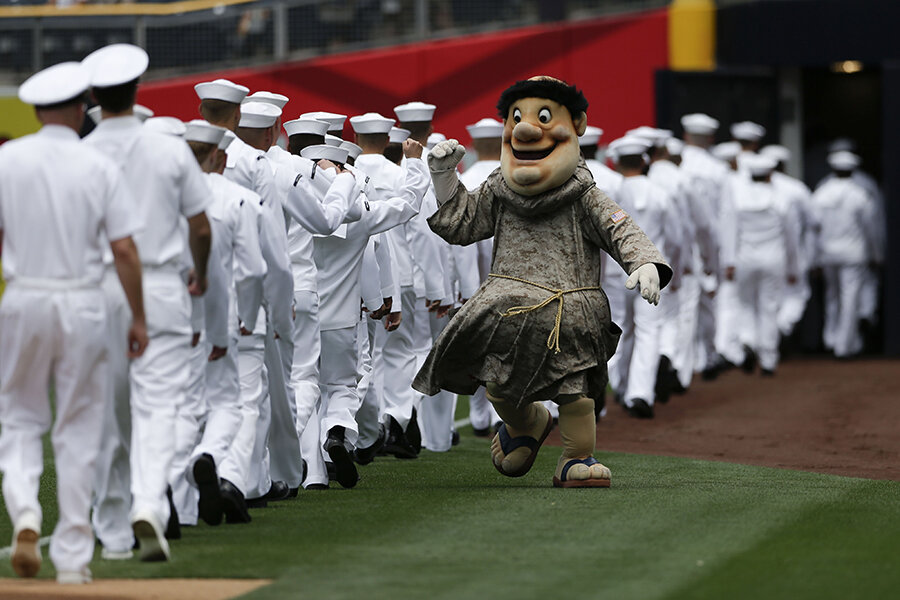'Where are my fries?' Navy not all happy with more nutritious menu
Loading...
Taking fried foods, whole milk, and other comfort foods off the Navy’s menu may make sailors and naval aviators more fit to fight. But, at the moment, it’s making many fighting mad.
The program is similar in concept and implementation to first lady Michelle Obama’s changes to school lunch menus in order to boost healthy lifestyles.
Citing the SEALs' "Fuel to Fight" program as an example, Navy Secretary Ray Mabus announced back in May that vast changes affecting food and fitness were coming. Secretary Mabus has set his sights on a well-balanced diet, which he referred to as "the foundation of a healthy lifestyle" he hopes will make sailors more fit to fight.
The SEAL plan increases the availability of lean proteins, vegetables, and complex carbohydrates to fuel, rather than feed, the warfighter. Other galleys have implemented "Go for Green," a Department of Defense (DoD) nutrition program that teaches sailors to recognize and select healthier foods.
In 2014, the Navy Nutrition Program teamed up with the DoD Combat Feeding Research and Development Center and the Culinary Institute of America “to improve and create 50 new recipes and replace some of the decades old Armed Forces Recipe Service Cards,” according to the Navy website. Those “Go Green” cards which use a “stop light system” to identify foods high in nutritional quality to enhance performance, mood and help manage body weight are now available in mess halls.
However, taking away the deep fryers and whole milk options from chow halls across the country is upsetting some Navy personnel, leading them to vent their frustrations and blame the first lady for the changes on social media.
Others on Facebook favored exercise increase over dietary restrictions.
“Ain't gonna work,” commented John-florida Killin to the Facebook posting. “In my day, if I couldn't get fried chicken or fish n'chips from the mess decks, I'd buy it in town. I think this is just an excuse to spend less on food (During Vietnam Nam, we were actually getting grade B meat several meals a week because of some corrupt supply officers who were being bribed.) These people are U.S. Navy sailors. They don't need some doodle bug nanny from that stupid medical service corps coming around telling them what to eat. Hold people accountable during the annual PFT, AND ACTUALLY KICK THE ONES OUT WHO CAN'T PERFORM.”
“No more deep fried soft shell crabs, Freedom Fries, Fried Chicken, Hush Puppies.... There goes the taste. Hope the Air Force doesn't follow suit,” commented Bob Judd. “Their cooks always made awesome chow, when they visited.”
Darya Rose, neuroscience Ph.D, author of the book “Foodist,” and founder of the site Summer Tomato, says in an interview that the new focus on nutrition in the Navy's diet may be far more effective than the changes made in the national school lunch programs.
“When you’re imposing it on your children, for example, at schools it won’t work because kids don’t understand the health and performance components and can just trade lunch for chips with other kids,” Ms. Rose says. “However what the Navy did was smart because it really put the emphasis on performance and recovery.”
Rose adds that telling people that something will be good for them in years to come “is too abstract” while, “You can understand the emphasis on performance as consequences that are immediate and beneficial.”
“You can feel a very strong difference in performance if you eat healthier and I thought that was a really smart tactic,” Rose says. “If you value performance it’s a much stronger argument than in the school telling kids they shouldn’t have soda. They aren’t saying I want you guys to weigh less or avoid diabetes or heart disease. They are saying this is what we’re doing for your job performance and your benefit and I think that’s really smart.”
Ultimately, the key to this program’s success, according to Rose, will be the Navy’s ability to have its chefs make the food taste good.
“Most people’s experience with vegetables it having them steamed, no fat on it, no salt, industrialized vegetables and that just doesn’t taste good,” she says. “I think we’ve gone past the 1980s argument that fat is the enemy in the nutrition world. The key is offering foods that are healthy, but that taste really, really good. It sounds like the Navy chefs understand that. Obviously, we’ll see how they execute on that.”








